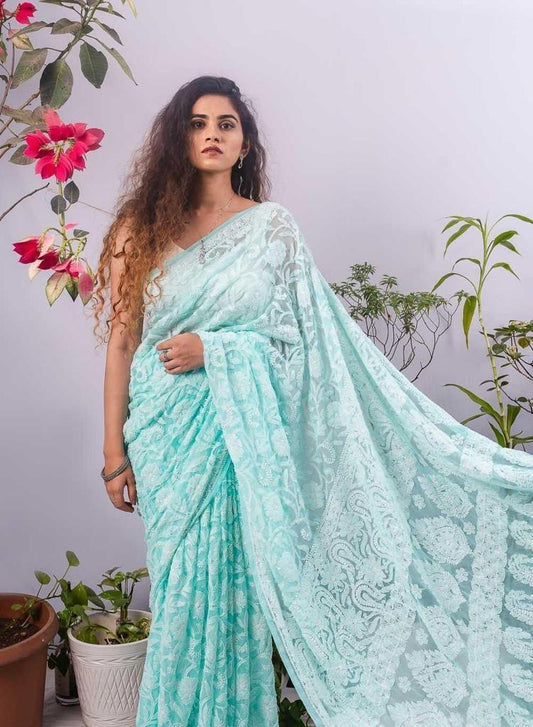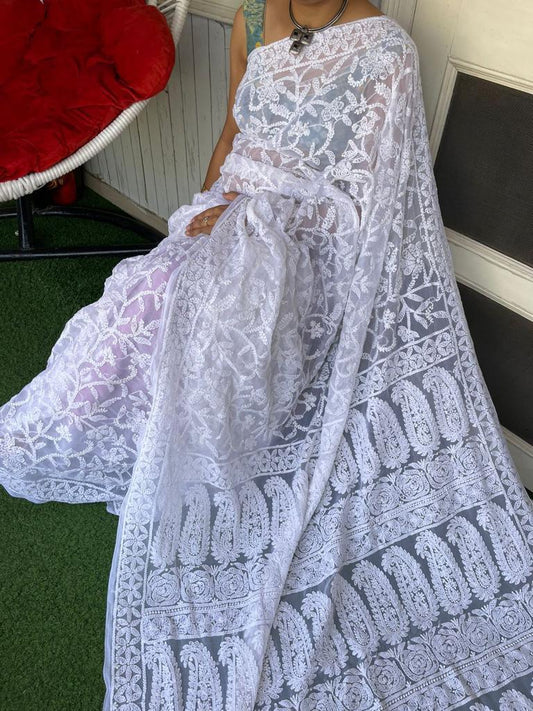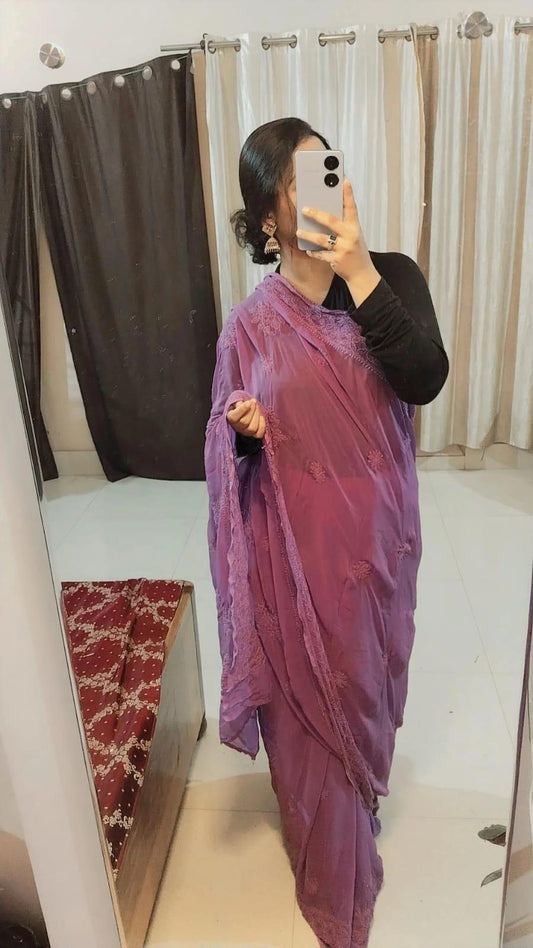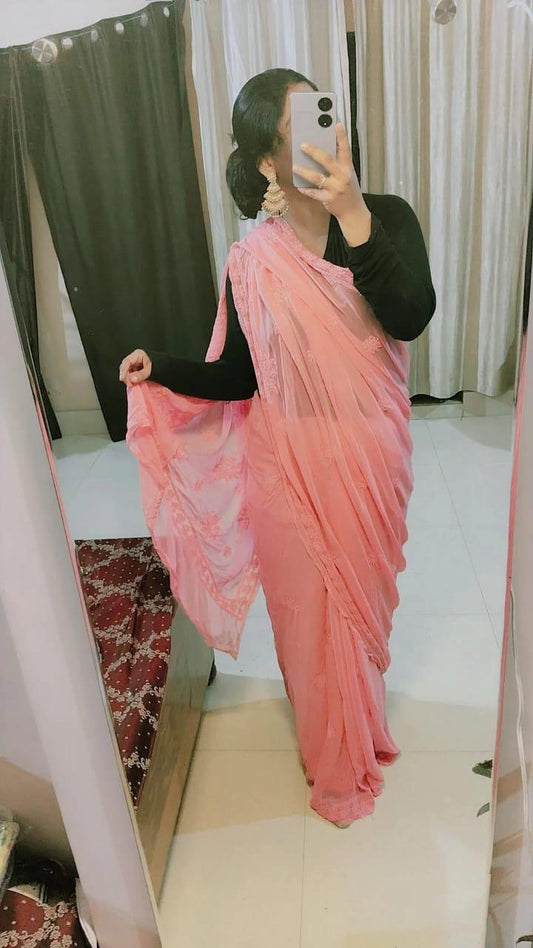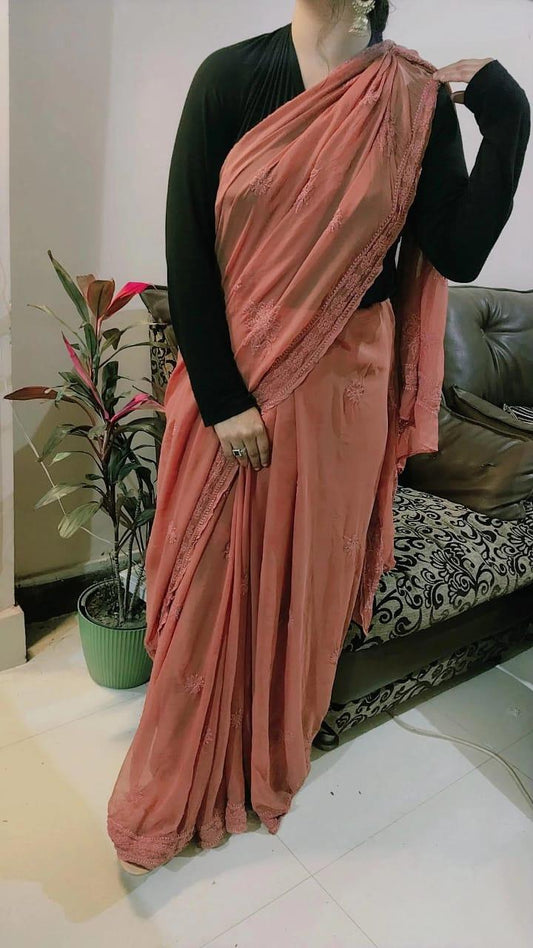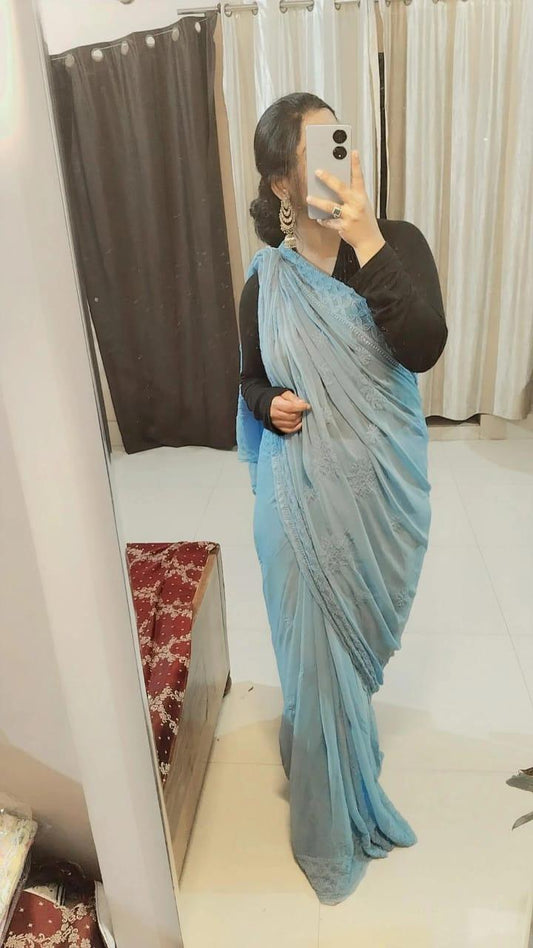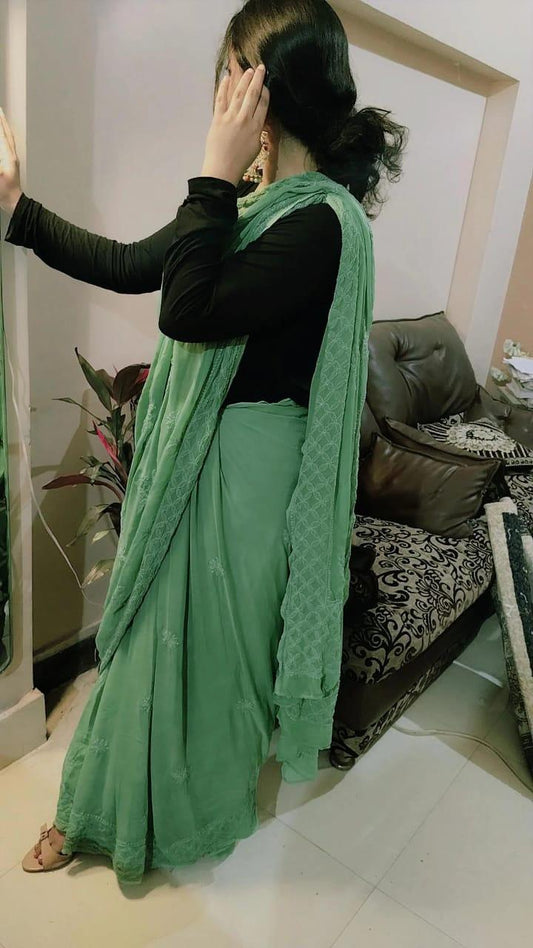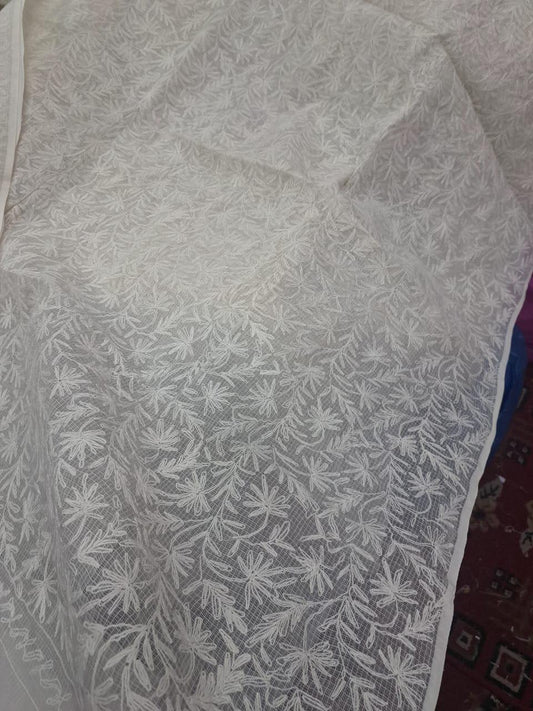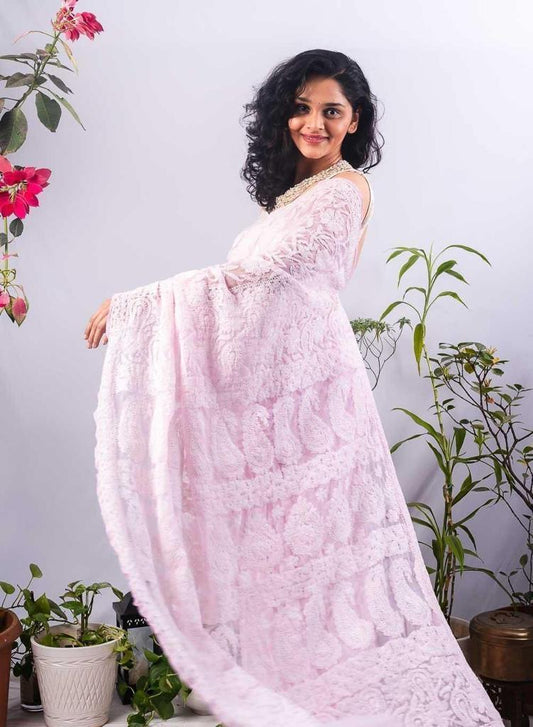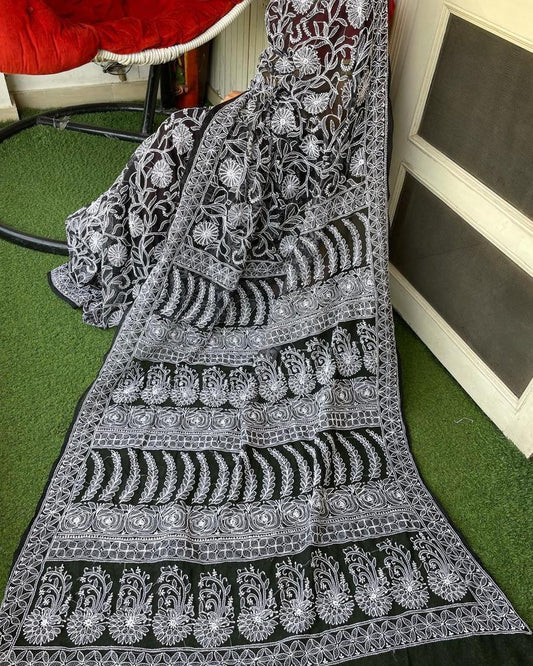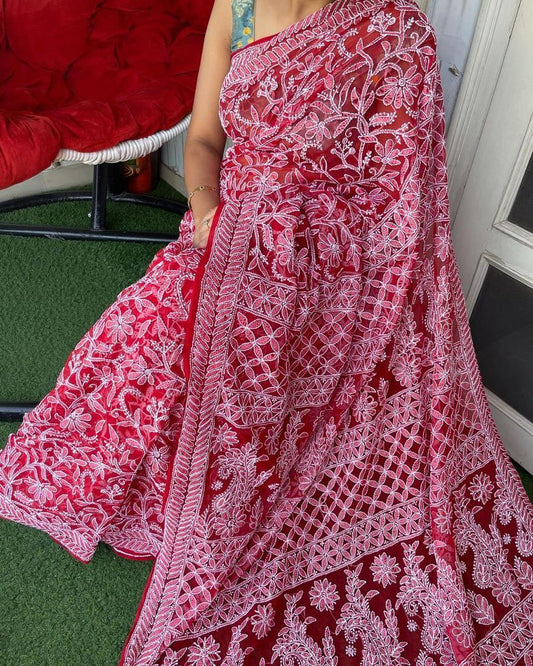- Collection
- Lakhnavi saree
Collection: Lakhnavi Saree
What is a Lakhnavi Saree?
A Lakhnavi saree, also known as a Lakhnavi Saree is a traditional Indian garment that features the exquisite Chikankari embroidery originating from Lucknow, Uttar Pradesh. These sarees are renowned for their intricate and delicate hand-embroidered patterns, which add a touch of elegance and sophistication to the fabric.
Key Features of Lakhnavi Saree
Chikankari Embroidery:
Origin:
Chikankari is an ancient embroidery technique that dates back to the Mughal era. It involves creating intricate patterns using a variety of stitches.
Stitches Used: Common stitches in
Chikankari include backstitch, chain stitch, hemstitch, and the unique "shadow work" which creates a shadow-like effect on the fabric.
Designs: The embroidery typically features floral motifs, paisleys, and intricate geometric patterns.
Fabrics:
Materials:
Chikankari sarees are crafted from a range of fabrics including cotton, georgette, silk, chiffon, and muslin. Each fabric brings out the
Chikankari work differently, making it suitable for various occasions and seasons.
Breathability and Comfort: Fabrics like cotton and muslin are lightweight and breathable, ideal for hot climates, while silk and georgette add a more luxurious feel, perfect for formal events.
Craftsmanship:
Handmade: Each Lakhnavi saree is hand-embroidered by skilled artisans, making every piece unique.
Time-Consuming: The intricate work can take anywhere from a few days to several months to complete, depending on the complexity of the design.
Styles and Variations:
Plain Sarees with Heavy Pallu: These feature a plain body with a heavily embroidered pallu (the decorative end of the saree draped over the shoulder), creating a striking contrast.
All-Over Embroidery: Some sarees are adorned with
Chikankari work all over, giving a richly decorated appearance.
Borders and Bootis: Many sarees have intricate borders and scattered small motifs (bootis) throughout the fabric.
How to Style a Lakhnavi Saree
Blouse Pairing:
Contrasting Blouse: Pair with a contrasting blouse to highlight the embroidery.
Matching Blouse: For a more cohesive look, choose a blouse that matches the saree’s base color and embroidery style.
Accessorizing:
Jewelry: Traditional Indian jewelry like jhumkas (dangly earrings), bangles, and a statement necklace can enhance the overall look.
Footwear: Opt for embellished sandals or traditional juttis (flat shoes).
Occasions:
Casual and Semi-Formal: Cotton or muslin Lakhnavi sarees are perfect for day events and casual gatherings.
Formal and Festive: Silk, georgette, and chiffon versions are ideal for weddings, festivals, and formal occasions.
Care Instructions
Washing: Hand wash or dry clean to maintain the integrity of the embroidery.
Storing: Store in a cool, dry place. Use a cotton or muslin cloth to wrap the saree to prevent damage to the delicate work.
Ironing: Use a low-heat setting and iron on the reverse side to avoid damaging the embroidery.
Conclusion
A Lakhnavi Saree is more than just a piece of clothing; it is a work of art that embodies the rich cultural heritage and skilled craftsmanship of Lucknow. Whether worn for a casual outing or a grand celebration, these sarees make a timeless and elegant addition to any wardrobe.
-
Teal Green Color Full Jaal Chikankari Saree by Inayakhan
Regular price $135.00 USDRegular priceUnit price / per$160.00 USDSale price $135.00 USDSALE -
White Color Full Jaal Chikankari Saree by Inayakhan
Regular price $135.00 USDRegular priceUnit price / per$160.00 USDSale price $135.00 USDSALE -
Wine Elegant Chikankari Georgette Saree with Black Blouse Perfect for Bridesmaids
Regular price $75.00 USDRegular priceUnit price / per$79.00 USDSale price $75.00 USDSALE -
Purple Elegant Chikankari Georgette Saree with Black Blouse Perfect for Bridesmaids
Regular price $75.00 USDRegular priceUnit price / per$79.00 USDSale price $75.00 USDSALE -
Pink Elegant Chikankari Georgette Saree with Black Blouse Perfect for Bridesmaids
Regular price $75.00 USDRegular priceUnit price / per$79.00 USDSale price $75.00 USDSALE -
Peach Elegant Chikankari Georgette Saree with Black Blouse Perfect for Bridesmaids
Regular price $75.00 USDRegular priceUnit price / per$79.00 USDSale price $75.00 USDSALE -
Light Blue Elegant Chikankari Georgette Saree with Black Blouse
Regular price $75.00 USDRegular priceUnit price / per$79.00 USDSale price $75.00 USDSALE -
Green Elegant Chikankari Georgette Saree with Black Blouse
Regular price $75.00 USDRegular priceUnit price / per$79.00 USDSale price $75.00 USDSALE -
Classic White Hand-Embroidered Chikankari Kota Saree with Matching Blouse
Regular price $135.00 USDRegular priceUnit price / per$79.00 USDSale price $135.00 USD -
Wine Color Full Jaal Chikankari Saree by Inayakhan
Regular price From $125.00 USDRegular priceUnit price / per$160.00 USDSale price From $125.00 USDSALE -
Light Pink Color Full Jaal Chikankari Saree by Inayakhan
Regular price $135.00 USDRegular priceUnit price / per$160.00 USDSale price $135.00 USDSALE -
Black Color Full Jaal Chikankari Saree by Inayakhan
Regular price $135.00 USDRegular priceUnit price / per$160.00 USDSale price $135.00 USDSALE -
Red Color Full Jaal Chikankari Saree by Inayakhan
Regular price From $125.00 USDRegular priceUnit price / per$160.00 USDSale price From $125.00 USDSALE


